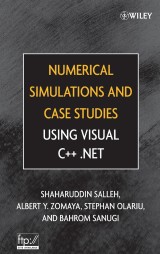Details

Numerical Simulations and Case Studies Using Visual C++.Net
1. Aufl.
|
136,99 € |
|
| Verlag: | Wiley |
| Format: | |
| Veröffentl.: | 17.06.2005 |
| ISBN/EAN: | 9780471727248 |
| Sprache: | englisch |
| Anzahl Seiten: | 400 |
DRM-geschütztes eBook, Sie benötigen z.B. Adobe Digital Editions und eine Adobe ID zum Lesen.
Beschreibungen
Master the numerical simulation process required to design, test and support mobile and parallel computing systems. An accompanying ftp site contains all the Visual C++ based programs discussed in the text to help readers create their own programs. With its focus on problems and solutions, this is an excellent text for upper-level undergraduate and graduate students, and a must-have reference for researchers and professionals in the field of simulations.<br /> <br /> More information about Visual C++ based programs can be found at: ftp: //ftp.wiley.com/public/sci_tech_med/numerical_simulations/
Preface. <p><b>1. Developing Applications Using Visual C++.Net.</b></p> <p>1.1 Object-Oriented Approach to Visual C++.Net.</p> <p>1.2 MFC Fundamental Features.</p> <p>1.3 Writing Applications Using MFC.</p> <p>1.4 Writing the First Nonwizard Program.</p> <p>1.5 Discussion.</p> <p>1.6 Summary and Conclusion.</p> <p>Bibliography.</p> <p><b>2. Interfaces for Numerical Problems.</b></p> <p>2.1 Visualizing a Numerical Problem.</p> <p>2.2 Handling Arrays.</p> <p>2.3 Finding the Root of a Nonlinear Equation.</p> <p>2.4 Solving a System of Linear Equations.</p> <p>2.5 Summary and Conclusion.</p> <p>Bibliography.</p> <p>Code Listings.</p> <p><b>3. Matrix Operations Using Wizard.</b></p> <p>3.1 Document/View Architecture Using Wizard.</p> <p>3.2 Matrix Algebra.</p> <p>3.3 System of Linear Equations Problem Revisited.</p> <p>3.4 Summary and Conclusion.</p> <p>Bibliography.</p> <p>Code Listings.</p> <p><b>4. Differential Equations Problems.</b></p> <p>4.1 Differential Equations.</p> <p>4.2 Ordinary Differential Equations.</p> <p>4.3 Partial Differential Equations.</p> <p>4.4 Summary and Conclusion.</p> <p>Bibliography.</p> <p>Code Listings.</p> <p><b>5. Drawing Curves.</b></p> <p>5.1 Windows Graphics Representation.</p> <p>5.2 MFC Functions for Displaying Graphics.</p> <p>5.3 Drawing a Curve.</p> <p>5.4 Cubic Spline Interpolation.</p> <p>5.5 Summary and Conclusion.</p> <p>Bibliography.</p> <p>Code Listings.</p> <p><b>6. Working with Images.</b></p> <p>6.1 Handling Images.</p> <p>6.2 Bitmap File Format.</p> <p>6.3 Edge-Detection Problem.</p> <p>6.4 Summary and Conclusion.</p> <p>Bibliographical Note.</p> <p>Code Listing.</p> <p><b>7. Visualizing a Graph.</b></p> <p>7.1 Elementary Graph Concepts.</p> <p>7.2 Graph Visualization Model.</p> <p>7.3 Minimum Spanning Tree Problem.</p> <p>7.4 Summary and Conclusion.</p> <p>Bibliography.</p> <p>Code Listings.</p> <p><b>8. Graph Applications.</b></p> <p>8.1 Graph-Network Relationship.</p> <p>8.2 Shortest-Path Problem.</p> <p>8.3 Mesh Network Applications.</p> <p>8.4 Summary and Conclusion.</p> <p>Bibliography.</p> <p>Code Listings.</p> <p><b>9. Multiprocessor Scheduling Problem.</b></p> <p>9.1 Parallel Computing Systems.</p> <p>9.2 Task Scheduling Problem.</p> <p>9.3 Task Scheduling Visualization Model.</p> <p>9.4 Summary and Conclusion.</p> <p>Bibliography.</p> <p>Code Listings.</p> <p><b>10. Discrete-Event Simulation.</b></p> <p>10.1 Concepts of Simulation.</p> <p>10.2 Simulation Model Development.</p> <p>10.3 Discrete-Event System Simulations.</p> <p>10.4 Multicounter System with Blocking.</p> <p>10.5 Queueing Systems.</p> <p>10.6 Summary and Conclusion.</p> <p>Bibliography.</p> <p>Code Listings.</p> <p><b>11. Modeling Wireless Networks.</b></p> <p>11.1 Wireless Cellular Networks.</p> <p>11.2 Channel-Assignment Problem.</p> <p>11.3 Channel Assignments: Discrete Model.</p> <p>11.4 Solving the Channel-Assignment Problem.</p> <p>11.5 Summary and Conclusion.</p> <p>Bibliography.</p> <p>Code Listings.</p> <p>Index.</p>
"I recommend this book to anybody that needs to develop computer applications for numerical analysis." (<i>Computing Reviews.com</i>, July 3, 2006) <p>"The coverage of each topic is brief but thorough." (<i>CHOICE</i>, December 2005)</p>
<b>SHAHARUDDIN SALLEH</b>, PhD, is Associate Professor, Computational Mathematics Department, Universiti Teknologi Malaysia. He has widely published research articles and books in parallel computing algorithms, mobile computing, intelligent systems, and numerical/combinatorial optimization problems. <p><b>ALBERT Y. ZOMAYA</b>, PhD, is CISCO Systems Chair Professor of Internetworking, School of Information Technologies, The University of Sydney. His research interests include high-performance computing, parallel algorithms, mobile computing, networking, and bioinformatics. He is a Fellow of the IEEE.</p> <p><b>STEPHAN OLARIU</b>, PhD, is Professor, Computer Science, Old Dominion University. His research focuses on image processing and machine vision, parallel architectures, design and analysis of parallel algorithms, computational graph theory, computational geometry, and mobile computing.</p> <p><b>BAHROM SANUGI</b>, PhD, is Professor, Numerical Analysis and Computing, Universiti Teknologi Malaysia. His research interests include neural networks and numerical algorithms.</p>
<b>Learn how Visual C++ can solve numerical simulation problems</b> <p>Readers learn how to master the numerical simulation process required to design, test, and support mobile and parallel computing systems. By presenting a series of straightforward program examples as a foundation, the authors show how problems in numerical methods and simulations are skillfully solved with the aid of Visual C++. The publication promotes quick learning by meeting three key objectives:</p> <ul> <li>Filling the gap in the literature by concurrently examining problems in numerical methods and simulations alongside their solutions using Visual C++</li> <li>Presenting solutions in a visual, reader-friendly style</li> <li>Focusing on the problem and minimizing the coding by using the non-wizard approach in Microsoft Foundation Class (MFC), making the solutions easier to understand</li> </ul> <p><b>Chapters cover all the topics needed to master Visual C++:</b></p> <ul> <li>Developing applications using Visual C++ .Net</li> <li>Interfaces for numerical problems</li> <li>Matrix operations using wizard</li> <li>Differential equation problems</li> <li>Drawing curves</li> <li>Working with images</li> <li>Visualizing a graph</li> <li>Graph applications</li> <li>Multiprocessor scheduling problem</li> <li>Discrete-event simulation</li> <li>Modeling wireless networks</li> </ul> <p>Each chapter contains at least one case study, enabling readers to learn by example. These studies represent today's hot research topics, including linear equations, graph construction and optimization problems, edge detection in images, multi-counter discrete-event simulations, and channel assignments for wireless cellular networks.</p> <p>An accompanying ftp site contains all the Visual C++–based programs discussed in the text to help readers create their own programs. With its focus on problems and solutions, this is an excellent text for upper-level undergraduate and graduate students, and a must-have reference for researchers and professionals in the field of simulations.</p>

















